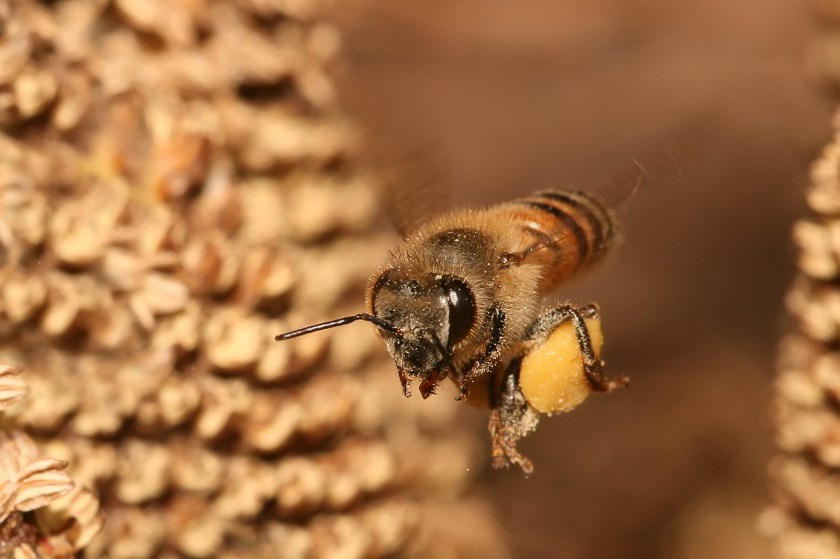Ever hear of zombie bees? Me neither. I didn’t know about them until my wife sent me an article posted on Facebook featuring these unfortunate creatures. For a while there, I thought it was a joke. You know the kind, “Two-Headed Dog Discovered in Ecuador.” But after having read the blurb, I knew I had stumbled upon something different. And different is what Monday Mayhem is all about.
![Honeybee [Photo Credit: Used in accordance with the GNU Free Documentation License]](https://lookingtogod.org/wp-content/uploads/2014/02/apis_mellifera_flying.jpg?w=300&h=199)
Scientists call the flies Apocephalus borealis. What they are really is parasites that latch on to European honeybees, laying their eggs and causing nothing but chaos to these gentle insects of nature. As the eggs grow, the bees lose their ability to control their motor muscles. Once the eggs hatch, the bees die.
Reminiscent of the movie Alien where the creature inhabits the body of its host until such time that it explodes in a birth of gory proportions, the parasite’s eggs reside in the bee’s body and feeds on its host’s nutrients.
Discovered in Maine in the 1920s, the parasite had infested yellow jacket hornets and bumblebees. This is the first time these critters have ventured to attack honeybees.
![Ophiocordyceps unilateralis [Photo Credit: Used in accordance with the Creative Commons Attribution 2.5 Generic license]](https://lookingtogod.org/wp-content/uploads/2014/02/ophiocordyceps_unilateralis.png?w=208&h=300)
What makes the fungus so fascinating is how it infects the ant by invading the cuticles and consuming the non-vital tissues much like a yeast infection. As the infection spreads to the brain, the ant begins to convulse, dropping from its canopy and losing the ability to control its muscle functions. At this point, the ant becomes a zombie, slave to the infection that inhabits its body. The infection leads the ant to a suitable plant where it causes it to lock its jaws on one of the veins of a leaf and die a miserable death.
It gets better. Whole ant colonies have died due to the Ophiocordyceps unilateralis infection. The cure? There isn’t one. Fossil leaf from the Messel Pit in Germany indicates the fungus may have been around for more than 48 million years. That’s a long time for something to have outlasted extinction. Nonetheless, the ant colonies’ only recourse has been to drag the infected from populated areas in order for them to die alone, away from the multitude.
Perhaps there’s a lesson there for all of us.
Have you ever heard of the Apocephalus borealis parasite or the Ophiocordyceps unilateralis fungus?

Reblogged this on The TV Media Junkie ReBlog Blog.
Very interesting post Sir. Prior to reading I had no knowledge of either circumstance. I’m no scientist, so please excuse my lack of accurate terminology, but I know of a wasp, which has the ability to paralyze a cockroach with some kind of mind altering poison, hence by rendering it a zombie slave. This causes the cockroach to head in the direction the wasp wants, before laying its eggs inside the body of said cockroach. That way, the children which erupt have a snack to eat as they make their way into the big bad world.
Aren’t you glad we’re not insects!
My husband told me about the fungus ant zombies a while back – definitely the type of thing you WISH was just part of some quirky Sci-Fi or horror story.
Creepy!! Bugs are bad enough without being zombie superbugs. I don’t think I want to live on this planet any more.
Just heard about this same thing on the behind the scenes extras on the World War Z Blu-ray! It was some of the inspiration for the zombies in the movie.
Wow. That’s crazy…!
Part of my research for my ZA story and the virus which causes it, I studied the zombie ants. Zombie honey bees is new to me, but I am not surprised.
What is interesting though, is that the Apocephalus borealis flies are infesting new hosts, crossing species. The American bee keeper has a difficult time keeping his bees alive as it is without another stressor on his hives.
I wonder if anyone has thought of a way to incorporate Apocephalus borealis into their ZA fiction?
this is exactly why zombies scare me the most. the parasite-causing-zombie-like behavior is out there. evolution, if not on our side, could possibly show a dreary future for mankind.
and with that note – this sunday, the walking dead returns! :p
That’s pretty cool. I kinda feel sorry for the poor creatures, though. Great post!
I think I had heard about it, somewhere along the line, but it was lost to the dim corners of my memory. This was a great – but really sad (I feel so sorry for the bees) – post, Jack!
I haven’t played it yet, but I think the video game The Last of Us uses this fungus as a premise for their zombies. Somehow, the fungus makes the jump to humans.
I just read about the zombie bees and was a little disappointed that they weren’t eating the other bees.
Okay. This was educational. 🙂 Creepy, but educational. 🙂